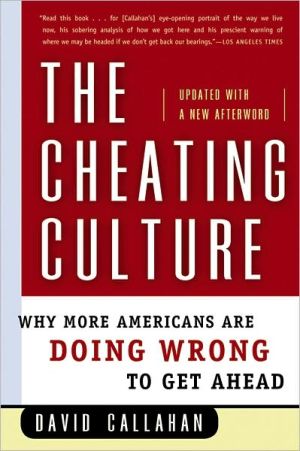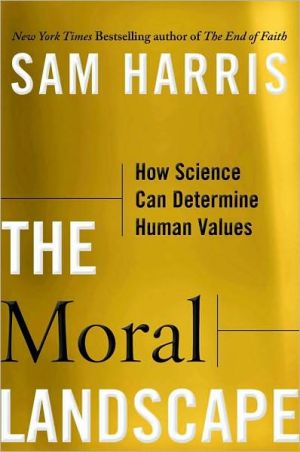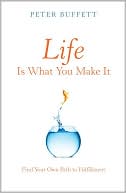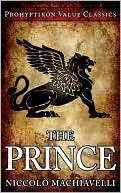The Cheating Culture: Why More Americans Are Doing Wrong to Get Ahead
Free cable television. Imaginary tax deductions. Do you take your chance to cheat? David Callahan thinks many of us would; witness corporate scandals, doping athletes, plagiarizing journalists. Why all the cheating? Why now?\ Callahan blames the dog-eat-dog economic climate of the past twenty years: An unfettered market and unprecedented economic inequality have corroded our values and threaten to corrupt the equal opportunity we cherish. Callahan's "Winning Class" has created a separate...
Search in google:
Callahan, a co-founder of the public policy center Demos, identifies America's free-wheeling economic climate of the past 20 years as the cause of rampant cheating--corporate scandals, doping in sports, plagiarism by journalists and students, and corner-cutting in the most mundane matters--that is a major hidden cost of the boom years. The "Winning Class," he argues, has the money and clout to cheat without consequences, while the growing "Anxious Class" believes that choosing not to cheat will cost them their only shot at success in a winner-take-all world. Callahan uses interviews and data to show why all the cheating matters. Annotation ©2004 Book News, Inc., Portland, OR Publishers Weekly Newspapers have reported on many cases of corporate fraud at the highest executive levels in the past two years, but Callahan cites other instances of people going to often questionable lengths to succeed. It's estimated that half of all major league baseball players are taking steroids to enhance their strength and performance. Many attorneys regularly overstate their hours to stay competitive with their colleagues. To get into the right college, high schoolers will turn in papers written by tutors, while their parents shop for psychologists willing to diagnose a learning disability to gain extra time on the SAT. Callahan, director of public policy center Demos and frequent TV commentator, has a simple explanation for this proliferation of cheating. In a cutthroat economic climate, everybody wants to get ahead, and decades of deregulation have made it easy to bend the rules. He further argues that when the middle class sees wealthy cheaters get away with nothing more than a slap on the wrist, it inspires them to follow suit. A fairly obvious premise, to be sure, but the book's strength lies in tying together assorted detailed descriptions of cheating throughout the system and explaining the connections between disparate acts like r sum inflation, tax evasion and illegal downloads. He offers straightforward, commonsensical solutions, including increased funding for federal enforcement agencies. (Jan.) Copyright 2003 Reed Business Information.
"Everybody Does It"\ I PLAYED A LOT OF MONOPOLY GROWING UP. LIKE MOST PLAYERS of the game, I loved drawing a yellow Community Chest card and discovering a "bank error" in my favor-"Collect $200!" It never occurred to me not to take the cash. After all, banks have plenty of money and if one makes an error in your favor, why argue?\ I haven't played Monopoly in twenty years, but I'd still take the $200 today. And what if a real bank made an error in my favor? That would be a tougher dilemma.\ Such things do happen.\ Just to the east of where the Twin Towers once stood is a twenty-six-story office building that houses the Municipal Credit Union of New York City. The credit union has 300,000 members-federal, state, and city government employees-and over $1 billion in assets. Although a number of buildings near Ground Zero sustained serious damage when the towers came down, the MCU's glass-and-steel building on Cortlandt Street survived unscathed. However, the credit union did suffer a major computer failure that severed its link to the New York Cash Exchange (NYCE), the largest network of automatic teller machines in the Northeast.\ The network managers at NYCE quickly detected the severed link. The problem meant that while credit union members could withdraw money at cash machines, NYCE couldn't immediately track these transactions or prevent members from overdrawing their accounts. NYCE leaders managed to get through to the credit union staff, even though the organization was in chaos. They posed the following choice: With just a few strokes on a computer keyboard, NYCE could cut off all cash withdrawals until the severed link was restored-which could take several weeks-or NYCE could let the cash keep flowing and sort out the withdrawal records later. Theoretically, anyone with a credit union ATM card could take out as much money as they wanted. The credit union would have to assume that risk. What did it want to do?\ The Municipal Credit Union of New York is one of the oldest credit unions in America, founded more than eight decades ago. It is guided by an ethos of self-help and pooled aspirations. Many of its members are firemen and policemen and, in the wake of the attacks, it was widely assumed that some of these people had perished just across the street from the MCU's office. There was no way the credit union would prevent its members and their families from accessing their money at a time of crisis. Thomas Siciliano, the general counsel of the credit union, said later: "We felt it would have hurt them badly and added to the chaos of the city." The MCU trusted them to use their ATM cards responsibly.\ Credit union members realized early on that their ATM use wasn't monitored and that there was no limit to how much cash they could take out. As word spread, withdrawals skyrocketed. As many as 4,000 members overdrew their accounts, some by as much as $10,000. One member used his card more than 150 times between late September and mid-October.\ In November, the computer link with NYCE was finally restored. As the credit union got back to normal, it pieced together the full record of cash withdrawals after September 11. Those who had overdrawn their accounts had left a substantial electronic trail, and the MCU set about tracking them down. Siciliano led this work. He initially suspected that most of the members' overdrawing had occurred by accident, or maybe was prompted by emergency needs. The MCU assumed the best of its members, even those with average bank balances of less than $100 who had withdrawn thousands of dollars in just a few weeks. "We try to understand people," Siciliano says. "We're not just about the bottom line."\ The MCU sent letters to those with overdrawn accounts listing the money that was missing and asking for repayment. While some money was repaid, many letters got no response. More letters were sent-notarized letters with threats. After months of appeals, $15 million was still missing. At that point, the MCU called in the authorities. A criminal investigation, led by Manhattan District Attorney Robert Morgenthau and the New York City Police Department, extended into the following summer. It resulted in scores of arrests.\ A FEW BLOCKS AWAY from the credit union's offices, another investigation was reaching its climax in the spring of 2002, this one at Merrill Lynch's newly repaired global headquarters on Vesey Street. After September 11, Merrill Lynch had scattered 9,000 employees around back-office facilities in New Jersey and midtown. Months passed before it was able to move back downtown. When Merrill did return, morale at the company was low. Huge layoffs had depleted its ranks and profits were down in the new bear market. Worse, Merrill found itself cornered in a criminal probe led by New York State Attorney General Eliot Spitzer.\ Before his assault on Wall Street made him famous, Spitzer was an obscure state official. Those who did know him were reminded of a character straight out of early-twentieth-century America. Wealthy by birth, with a father who bankrolled his political career, Spitzer is a muckraking crusader for the public interest.\ Merrill Lynch had come to Spitzer's attention in a circuitous fashion. In early 2001, a Queens pediatrician named Debases Kanjilal hired a lawyer to pursue a civil suit against Merrill. Kanjilal was among the legions of investors who got burned when the NASDAQ cratered in 2000. Specifically, he had lost $500,000 on a single Internet stock, InfoSpace. Kanjilal's instinct had been to sell InfoSpace when it was trading at $60 a share. But his broker at Merrill Lynch had urged him to hold on to the stock, advice that reflected Merrill's public research reports that recommended InfoSpace as a "buy" stock. Standing behind those research reports, and affirming their recommendations in his TV appearances, was Merrill's star analyst and "Internet stock guru," Henry Blodget.\ It is hard today to appreciate the influence once wielded by Blodget. Just over thirty years old in 2000, Blodget was a Yale grad who had never aspired to stardom on Wall Street. He had tried instead to make it as a writer, and when that didn't work out, his father rescued him from unemployment by helping him land a position at Prudential Securities. Blodget's career was unremarkable until he shot to fame in 1998 with his prediction that Amazon's stock would reach the unthinkable price of $400 a share. When the stock did, in fact, hit that level a month later, Blodget was hailed as an oracle. Shortly thereafter he moved to Merrill Lynch with a $3 million contract. There, he reigned as the single most visible adviser to investors hoping to score big in the Internet gold rush. Blond and affable, with telegenic good looks, Blodget was everywhere with his stock predictions as well as broader prognostications about the new economy.\ What Blodget didn't mention to CNBC junkies or Merrill Lynch's own clients was that his role at Merrill went far beyond analyzing stocks. Like other star analysts of the time, he also became deeply involved in Merrill's investment banking business, helping to bring Internet companies-and fat underwriting fees-to Merrill. One of the companies Merrill's investment banking division represented was Go2Net, a company that InfoSpace was in the process of purchasing in 2000. Merrill had a financial interest in InfoSpace's stock price staying high so that the deal would go through.\ Debases Kanjilal held on to his InfoSpace stock even as it declined steadily. Finally he sold at $11 a share and took a staggering loss. At the time Kanjilal sold, Merrill and Blodget were continuing to recommend InfoSpace to investors. Kanjilal's losses were part of an estimated $4 trillion that investors lost when NASDAQ crashed. Big-name analysts hyped many sinking tech stocks with the same enthusiasm they'd shown in pumping them up. For example, as of May 2001, Morgan Stanley's top Internet analyst, Mary Meeker, was still bestowing her once-coveted "outperform" rating on Priceline, then down from $162 to $4, and on Yahoo!, down from $237 to $19.50.\ Kanjilal's lawsuit against Merrill Lynch attracted the attention of Eliot Spitzer's office not long after it was filed. Initiating a criminal investigation, Spitzer uncovered a shocking pattern of public deceit and conflict of interest at Merrill Lynch. He found e-mails by Henry Blodget privately ridiculing the same stocks that he and Merrill were publicly pushing. "A piece of junk," Blodget had called InfoSpace, even as he recommended it. He privately called other stocks a "pos," or piece of shit. Spitzer also found a memo in which Blodget detailed the compensation he deserved for bringing in investment banking business-a memo that flatly contradicted Merrill's claims that analysts were not rewarded for playing such a role. As a result of the investigation, Spitzer charged that Merrill Lynch's "supposedly independent and objective investment advice was tainted and biased by the desire to aid Merrill Lynch's investment banking business." In Spitzer's view, the behavior by Merrill and Blodget constituted securities fraud, a serious felony.1\ Spitzer's evidence against Merrill Lynch resulted in the company agreeing to pay a $100 million settlement. This case turned out to be just the first step in a larger investigation of other top Wall Street firms that had engaged in a range of abuses by insiders, which culminated in a historic $1.4 billion settlement in 2003.\ And what happened to Blodget? Not much. Saying he wanted a "lifestyle change," Blodget had accepted a November 2001 buyout offer from Merrill worth an estimated $5 million. He spent his days working on a book for Random House and meeting regularly with lawyers. In 2003, Blodget settled with Spitzer's office, agreeing to pay a $4 million penalty-yet admitting no wrongdoing. The settlement was easy enough to afford. Blodget had pulled in nearly $20 million during his brief star turn at Merrill.\ HENRY BLODGET and the ATM looters have nothing in common and much in common. Blodget was among the ranks of the big winners in the new economy-the very top earners who saw unprecedented income gains during the boom of the 1990s. His education and background had helped him to secure his place in the Winning Class: successful parents, private schools, Yale University, connections on Wall Street.\ The ATM looters, by contrast, were among the far larger ranks of Americans who had either stayed put economically or realized only modest gains during the boom years. They occupied the lower rungs of what Robert Reich has called the Anxious Class, and the 1990s were not easy for them. Although median wages for workers near the bottom crept up in the latter part of the decade, these gains did not make up for wage losses since the late 1970s and, in any case, were wiped out by large increases in the cost of living across the New York area. Records from the DA's office indicated that most of the ATM looters lived paycheck to paycheck with little money in the bank for emergencies. Some had average balances below $100 for months on end.\ Copyright © 2004 by David Callahan\ All rights reserved. No part of this publication may be reproduced or transmitted in any form or by any means, electronic or mechanical, including photocopy, recording, or any information storage and retrieval system, without permission in writing from the publisher.\ Requests for permission to make copies of any part of the work should be mailed to the following address: Permissions Department, Harcourt, Inc., 6277 Sea Harbor Drive, Orlando, Florida 32887-6777.
1"Everybody does it"12Cheating in a bottom-line economy283Whatever it takes634A question of character985Temptation nation1346Trickle-down corruption1677Cheating from the starting line1968Crime and no punishment2259Dodging Brazil259
\ The New York Times Book ReviewWell-constructed, civic-minded…full of compelling statistics and anecdotes.\ \ \ \ \ Los Angeles TimesOn-target analysis of how this noxious and, in the true sense, un-American corruption came to infect our culture.\ \ \ Deseret Morning NewsThe author provides persuasive evidence that our society is riddled with dishonesty.\ \ \ \ \ St. Petersburg TimesCallahan's on to something: an ingrained and growing national compulsion to succeed at any cost.\ \ \ \ \ Salon.comHair-raising. [P]acked with alarming anecdotes.\ \ \ \ \ Baltimore SunDozens of books have examined this phenomenon. None I have yet seen does it with [this] anger, vigor and persuasiveness.\ \ \ \ \ EsquireA damning and persuasive critique of America's new economic life.\ \ \ \ \ Philadelphia InquirerThis should be required reading for every high school and college student, and anyone who's ever complained about how bad things have gotten.\ \ \ \ \ Seattle TimesHighly readable. Callahan has done us a good turn by confronting the question of 'why do Americans do wrong?'\ \ \ \ \ Publishers WeeklyNewspapers have reported on many cases of corporate fraud at the highest executive levels in the past two years, but Callahan cites other instances of people going to often questionable lengths to succeed. It's estimated that half of all major league baseball players are taking steroids to enhance their strength and performance. Many attorneys regularly overstate their hours to stay competitive with their colleagues. To get into the right college, high schoolers will turn in papers written by tutors, while their parents shop for psychologists willing to diagnose a learning disability to gain extra time on the SAT. Callahan, director of public policy center Demos and frequent TV commentator, has a simple explanation for this proliferation of cheating. In a cutthroat economic climate, everybody wants to get ahead, and decades of deregulation have made it easy to bend the rules. He further argues that when the middle class sees wealthy cheaters get away with nothing more than a slap on the wrist, it inspires them to follow suit. A fairly obvious premise, to be sure, but the book's strength lies in tying together assorted detailed descriptions of cheating throughout the system and explaining the connections between disparate acts like r sum inflation, tax evasion and illegal downloads. He offers straightforward, commonsensical solutions, including increased funding for federal enforcement agencies. (Jan.) Copyright 2003 Reed Business Information.\ \ \ \ \ Village Voice"Callahan compiles a meticulous mountain of data about our current state of disgrace."\ \ \ \ \ \ Seattle Times"Highly readable. Callahan has done us a good turn by confronting the question of 'why do Americans do wrong?' "\ \ \ \ \ Library JournalCNN and NPR commentator and cofounder of the public policy center Demos, Callahan here presents a sordid picture of greed and corruption in American society. Though he provides broad coverage, he breaks little new ground in detailing instances of cheating in business, politics, and academia. Callahan's initially balanced tone shifts during the book, and the last section exhorts readers to take a stance and help to end cheating. The question of why more Americans are cheating is left mostly unexplored. The book's publicity blurb reads, "Callahan pins the blame on the dog-eat-dog economic climate of the past two decades," but he spends less time developing his arguments about why and how our culture arrived at this point than he does in pushing for cultural change. Callahan backs up his arguments, and the book contains adequate endnotes, but librarians looking for a thorough examination of this cultural development will find that this title is passionately argued but not sufficiently complex. Still, this work may be a popular choice in larger public libraries, and academic libraries may wish to consider.-Audrey Snowden, Brewer, ME Copyright 2003 Reed Business Information.\ \ \ \ \ School Library JournalAdult/High School-This is the kind of book that will have incredulous teens calling up their friends in order to read passages aloud. It's that scary. Callahan's premise is that, yes, there is a true moral crisis in this country, but it has nothing to do with so-called "family values"-and everything to do with the fact that more Americans are feeling the pressure to cheat to get ahead. From parents who bribe psychiatrists to diagnose their teens with phony mental disorders (buying the kids extra time for their SATs) to the Little League star pitcher who made it to the World Series before it was discovered that he was too old to be playing, the stories are amazing. Is there more cheating today than in years past? That's debatable, but Callahan makes a strong case that the 1980s, with their new emphasis on "leaner, meaner" companies and dog-eat-dog competition, created an atmosphere that makes cheating almost seem inevitable. One of the author's most important observations is that white-collar crime, often costing Americans billions of dollars, goes ridiculously unpunished while we lock up the poor for the most minor of drug offenses. People pat each other on the backs about successful tax evasion, which costs the government millions, but think a man who shoplifts a bottle of wine is deviant scum. Well-researched and very readable chapters on corruption in the sports world, in health care, on r sum s, and elsewhere will give teens much to talk (and probably shout) about. A perfect choice for a book-discussion group.-Emily Lloyd, formerly at Rehoboth Beach Public Library, DE Copyright 2004 Reed Business Information.\ \








